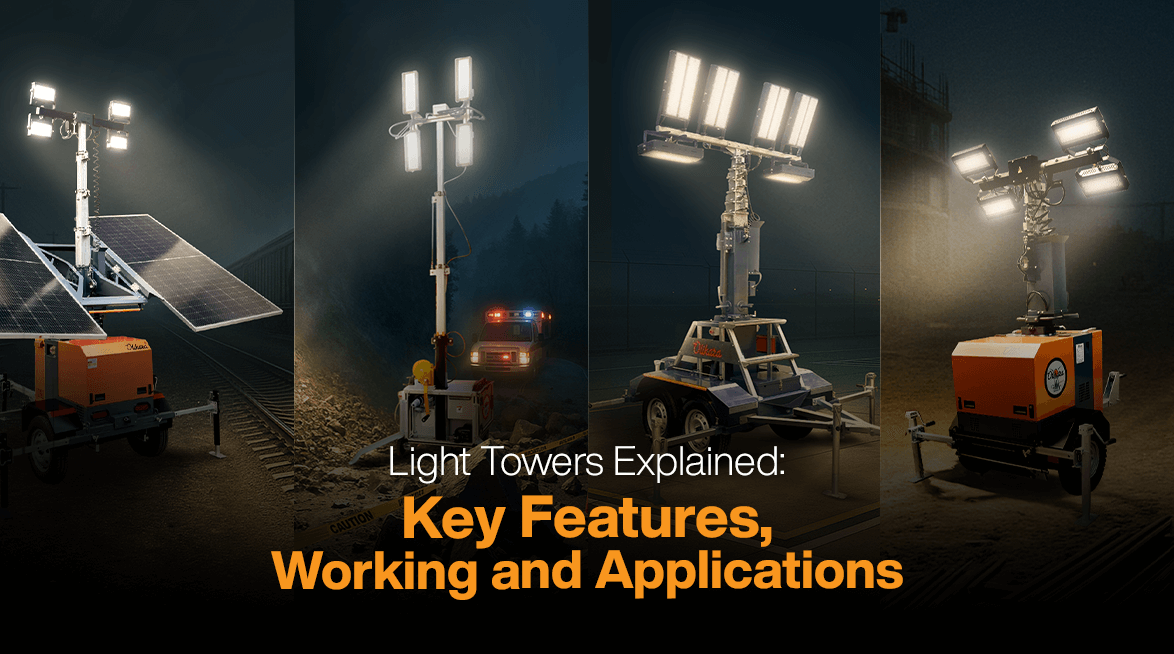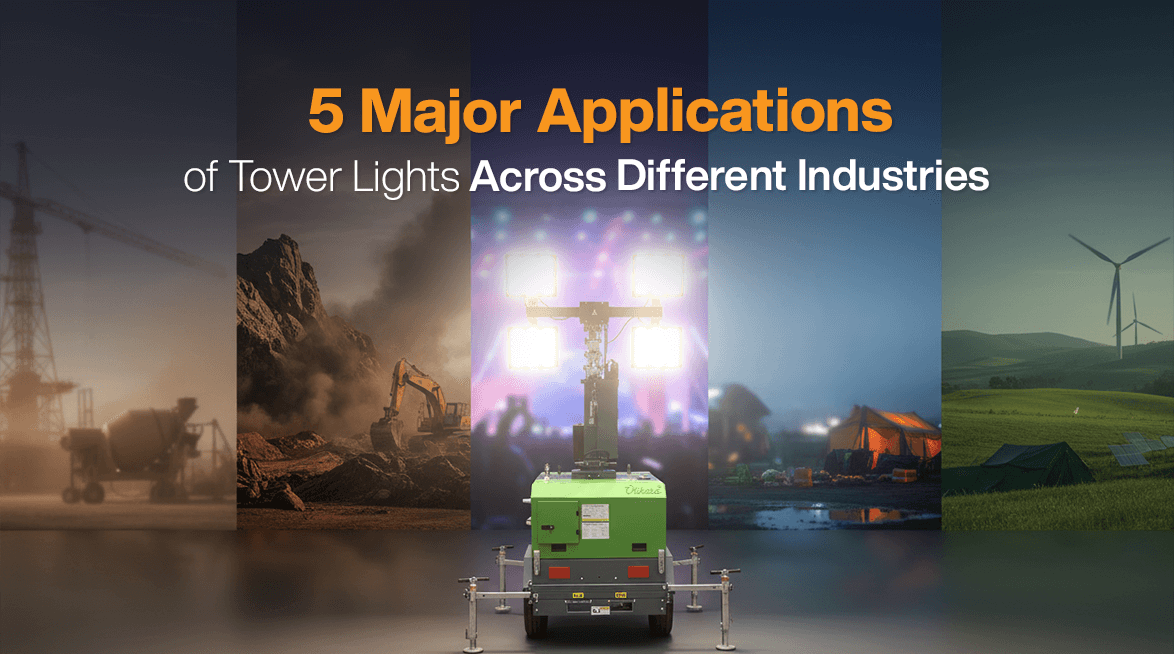
In industries where safety, productivity, and efficiency are a necessity, lighting becomes very important. In crowded construction sites, the underground mines, and in massive events, poor visibility may jeopardize the entire operation. Here, light towers come into play to provide high-power sources and make sure continuity in workflows, day and night.
Light tower manufacturers have re-determined the potential of these mobile lighting systems over the years. Towers are no longer mere metal halide lights that are mounted on poles; they now integrate sophisticated LED technology, various power supply options, compact mobility, and even renewable energy. With the necessity of industries to seek more green and efficient options, the development of light towers has not been left far behind.
This blog is a complete guide to light towers, including their key features, how they work, and their wide applications.
Understanding Light Towers: The Basics Explained
A Light tower is a mobile lighting system used to provide power illumination in a wide, outdoor, or remote area. Structurally, it is comprised of:
- Mast: This is a vertical pole that is extendable and can reach considerable lengths to ensure that the highest amount of light reaches the ground.
- Lamps: There are lights (bright halide or LED) mounted on the mast of the tower.
- Power Source: They are able to operate out of a generator, grid electricity, or renewable energy such as solar.
- Base and Mobility System: A trailer, skid, or compact base to move and stabilize the tower.
Light towers are needed in a place where a fixed lighting infrastructure is not practical or is not accessible. They ensure that the workers are safe, and they facilitate the workers to work long hours and provide emergency services in the crisis areas.
How Do Light Towers Work?
The principal working mechanism of a light tower is very simple and complex. Here’s a breakdown:
- Power Generation
- Powered with engines, they are either petrol or diesel generators.
- Units powered by grids pull the energy directly using the existing infrastructure.
- Hybrid/solar models combine renewable energy to reduce reliance on fuel.
- Raising the Mast
The telescopic mast can be a manual, hydraulic, or electric mast, and raised to an optimal height to place the lights. This guarantees a larger beam dispersion and reduced shadows.
- Lighting Distribution
LED lamps with high power produce uniform light coverage. As compared to the old halide lamps, LEDs have a longer life cycle, generate less heat, and consume less power.
- Mobility and Setup
Towers are mounted on skids or wheels and can be relocated to various locations within a very short time. Small tower designs fit into smaller work areas, whereas towers mounted on trailers are used in the heavy workload projects.
- Smart Controls
The latest light towers have programmable timers, motion sensors, and remote control mechanisms to streamline activities and conserve energy.
For example, trusted light tower manufacturers such as Olikara Lighting Towers offer top-notch light towers meeting all your diverse needs. Its compact devices, such as Qube Power Mini, can be used in smaller locations where a quick deployment is needed. The heavier models like Qube Power Max have a long working life, which is used to light up large areas like large buildings or mining areas.
Key Features of Modern Light Towers
Light towers are effective due to their suitability for different environments and needs. So, what are the fundamental characteristics of quality systems?
1. Stunning Lighting Performance
LED technology installed in modern towers gives:
- Clear as well as steady light
- Low consumption of fuel and high energy efficiency
- Extended periods of operation compared to halide lamps
2. Versatile Power Options
The possibility to select among the several power sources is among the characteristic features of light towers today:
- Engine-Powered: Applicable to remote or off-grid sites.
- Grid-Powered: Noise-free and environmentally friendly, ideal to use in events or urban areas.
- Hybrid/Solar: Hybrid means the merging of renewable energy and conventional power to be sustainable.
This versatility helps the users connect towers to certain site requirements.
3. Compact and Mobile Design
Mobility is a key advantage. Trailer-mounted Light towers are commonly easy to tow and are often trailer-mounted. Small towers such as the Qube Power Mini by Olikara can be easily placed in a small urban area or an emergency area.
4. Durability and Reliability
The nature of harsh working conditions requires strong equipment.
Modern towers are built with:
- Weather-resistant casings.
- Corrosion-proof coatings.
- Enhanced supporting masts for resistance to wind and uneven ground.
5. Smart Efficiency Features
New-generation towers are combined with:
- Auto on/off sensors.
- Motion detection systems.
- Fuel optimization features.
- Performance tracker by remote monitoring.
As an example, Olikara’s Qube Power Max Hybrid is a hybrid power source with intelligent controls that reduce fuel expenses without compromising the reliability of performance.
Applications of Light Towers
The light towers have become very common in such industries in which visibility and safety are paramount. Also, the market of light towers (globally) is projected to increase by 4.7 percent at a CAGR in the period between 2025 and 2033, owing to the developments in infrastructure, industrialization, and renewable integration. Thus, almost every industry requires light towers for power illumination.
The key applications are as follows:
1. Construction and Infrastructure Development
- Construction sites usually work past the daytime in order to meet the deadlines.
- Engine-powered light sources offer longer durability of light so that workers can work at night safely.
- They also minimize accident risks, particularly in places where heavy machines are used.
2. Mining and Oil & Gas Operations
- Remote and dangerous mines require high-power lighting that is dependable.
- Light is always available in off-grid settings due to engine-powered models like Olikara’s Qube Power.
- They are constructed using robust materials to be able to deal with harsh environments.
3. Public Events and Mass Gatherings
- Silent and environmentally friendly solutions are needed in festivals, concerts, and sports events.
- Grid-driven towers give a constant and noise-free lighting without interfering with the environment of the event.
4. Disaster Relief and Emergency
- Mobile towers bring life-saving light to the disaster-stricken areas, to facilitate rescue efforts.
- These situations require compact towers and are easily carried and installed within a short period.
5. Sustainable Projects
Companies that do not want to pollute the environment would choose a hybrid or solar-powered tower. An example of such products is Olikara’s Qube Solar, which does not require constant fuel consumption, which is why it is a sustainable solution to use in the eco-project.
Conclusion
Light towers are now essential in any industry that depends on high-quality, mobile, and powerful lighting. They are not only portable lamps but highly developed devices that are productive and safe due to advanced features, such as renewable energy integration, smart control, and strong designs.
Olikara Lighting Towers is one of the most reliable light tower manufacturers. At Olikara, we propose a variety of engine-powered, grid-powered, and hybrid-powered towers depending on the requirements of modern industry.
| Looking for a perfect light tower that meets your specific project requirements? Contact now! |
FAQs
- What are the applications of light towers?
Light towers are mobile, powerful lights that are employed to illuminate construction sites, events, mining, or emergencies where permanent lights are not possible.
- What industries are the best applications of light towers?
Light towers are required in several industries such as construction, mining, oil and gas, logistics, events, and disaster relief.
- Does Olikara Lighting Towers offer environmentally friendly light towers?
Yes, they offer hybrid and solar-powered light towers so that fuel consumption, emissions, and noise are reduced, which will make them sustainable alternatives.
- Which one should I choose? Engine-powered, grid-powered, or hybrid towers?
It depends on your project. Towers that are engine-powered are ideal in remote locations, grid towers in urban locations, and hybrid towers in eco-friendly or long-term cost-saving locations.




